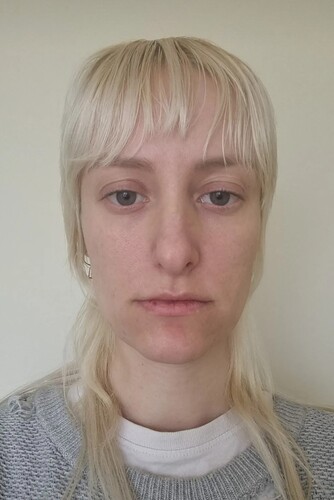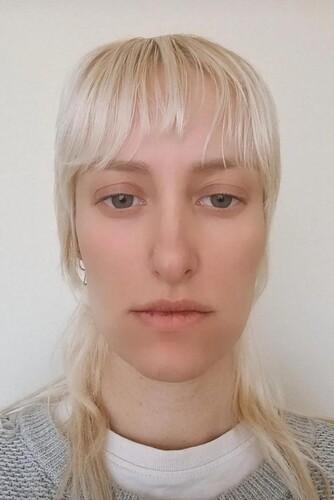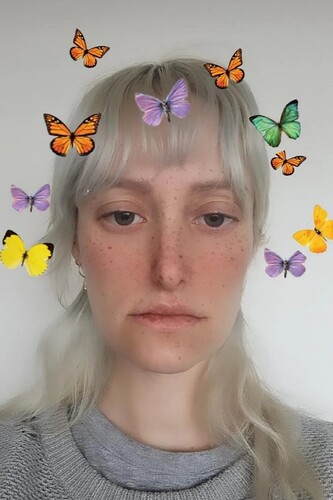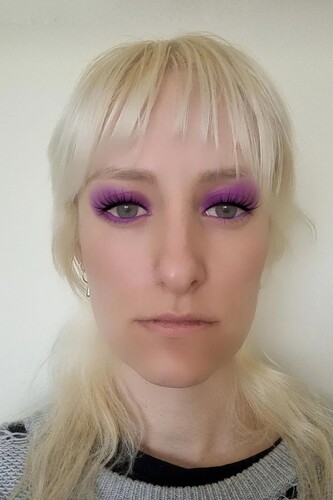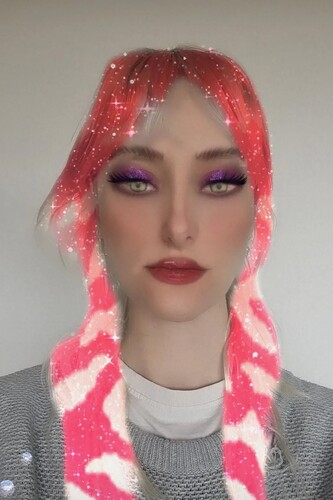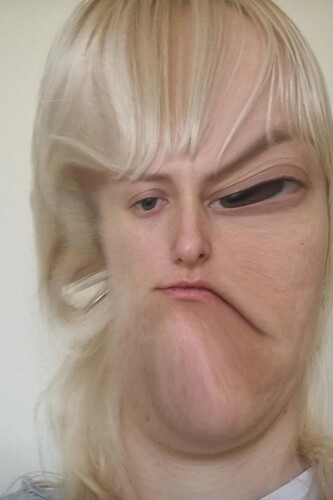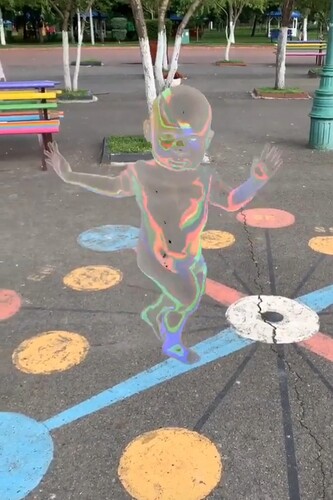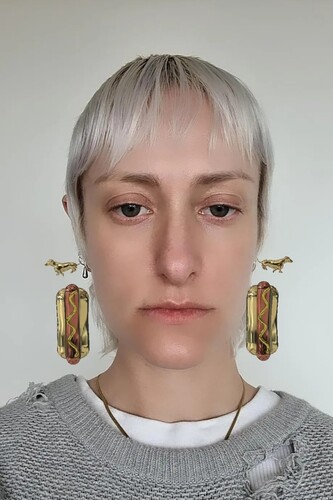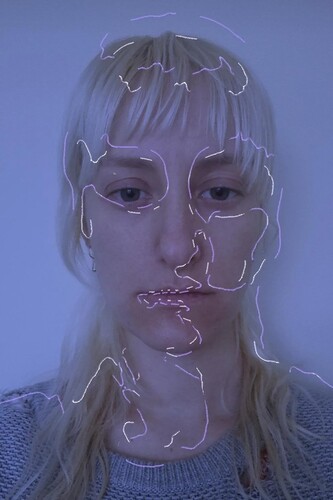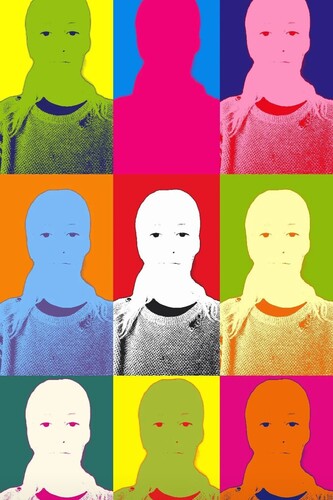Abstract
Augmented reality filters allow users of popular social media sites such as Instagram to change their appearance through the application of digital overlays that adhere to the user’s face. The instantaneous (and often ‘beautifying’) application of filters has seen them become much discussed amongst users, journalists and increasingly, academics. Despite the cultural ubiquity of filters in Western social media use, Instagram provides extremely limited data concerning what filters are popular, how filters are used and by whom. Coupled with their ephemerality, the obtuse and impermanent nature of Instagram’s AR filters present unique obstacles when studying this elastic technology. Addressing the difficulty of accessing Instagram filters as an ephemeral data set, this research uses a modified version of Light, Burgess, and Duguay (2018)’s ‘walkthrough’ method to manually create a stable and therefore quantifiable sample of 608 filters. I analyse this sample to establish an original typology of 12 common filter types: Surgery; Beauty; Makeup; Alt Beauty; Cyborgian; Digital Adornment; Character; Silly; World; Creative; Pastiche; and Aesthetic. This typology is accompanied by critical descriptions and a visual companion guide, providing direction on identifying each type and its traits. Finally, a brief qualitative analysis of the typology’s sample confirms that the beautifying Surgery filter type was the most common, and over half the sampled filters include skin smoothing, posing new considerations for how we may understand the proliferation of beautification affordances in filters broadly.
INTRODUCTION
Over the past decade, the increased popularity and capabilities of smartphones has seen augmented reality (AR) become an increasingly commonplace affordance within many mobile applications (apps). More recently, AR has moved from a novel experiential affordance of some apps to a pervasive feature of social media. The integration of AR has been most successful on image-based social media apps such as Snapchat and Instagram, where the technology is harnessed in the creation of what have become known as ‘filters’. Filters are interactive and allow the user to alter their appearance or surroundings through AR and have become culturally ubiquitous in Western social media use since their initial introduction by Snapchat in 2015. However, their popularity became firmly cemented once Instagram – a social media platform owned by MetaFootnote1 which boasts a significantly larger user base than Snapchat – duplicated the feature in 2017 (Constine Citation2017). As of 2021, over 2 million AR effects have been published across the Meta group of apps, though the majority of these effects originated (and are used) on Instagram (Meta Spark Citation2021). Of Instagram’s 1.28 billion users, 46% have accessed a filter effect at least once and over 700 million users across Meta’s suite of apps and devices engage with AR every month (Cook Citation2021; Dixon Citation2022; Ryan-Mosley Citation2021).
Beyond the statistics outlined above, there is little further information concerning the way in which Instagram filters are used. Broadly speaking, Meta frequently remains taciturn when it comes to sharing filter usage statistics and acknowledging concerns raised by the filter-using public. Whilst there are some broadly generalisable filter groupings presented to users in the app (‘appearance’, ‘aesthetic’, ‘games’, ‘humor’ and ‘special effects’), it is unknown how many filters belong to each of these categories, which are the most popular, how they are used and by whom – when interrogated, the most clarity a Meta spokesperson has provided is that ‘beauty filters are a “popular category” of effects’ (Ryan-Mosley Citation2021). At the time of writing, the publishing guidelines for filter creators proffer the only official public-facing acknowledgement of filter categories, with 17 categories that are incongruous (barring ‘appearance’ and ‘games’) with the aforementioned user-facing filter categories (Meta Spark Citation2024). Whilst appropriately located for filter creators, these categories are labyrinthically hidden from external parties such as researchers or journalists.
Platforms frequently cite such a need for secrecy and privacy in their technical developments in order to head off competition, particularly when concerned with algorithms and proprietary technologies (Cotter Citation2023). Through what is termed ‘blackboxing’, information relating to the inner workings of platforms, technologies and organisational operations is intentionally obscured or inaccessible (Langlois et al. Citation2009). A correctly-functioning technology renders the internal complexities ‘invisible’, leaving the input and output functions as the primary locus of user interaction (Latour Citation1999, 304). For the vast majority of Instagram users who do not also utilise Meta’s filter creation software Spark AR, the input and output stages can be reduced to a singular encounter point. The user ‘inputs’ their face (or environment) through the Instagram camera, and a filtered image is ‘output’. The platform’s functions – the algorithms that distribute the filters, how they are organised and categorised within the broader ecosystem of filters, how often a filter is used and by who – are all obscured from filter users and creators to varying degrees.
In order to begin demystifying the complex ecosystem of Instagram filters, this research takes a novel approach to data collection, coding and presentation. Due to the ephemerality of filters, along with the blackboxing of Instagram, there is no way to scrape or otherwise automate the collation of filters when applied to a user. This opacity serves a number of purposes – it renders filters near-inaccessible to researchers seeking to analyse the technology at a larger scale, it makes the detailed observation of problematic aspects (such as extremely ‘beautifying’ filters) more difficult, and the lack of cohesive and shared nomenclature obfuscates external inquiry. Indeed, ‘persistent inconsistencies [of] terminology’ have been shown to impede academic inquiry in a variety of fields and the lack of a common language to discuss filter types has already demonstrably complicated journalistic inquiry into the subject (Soria Citation2018, 49; Miller and McIntyre Citation2023).
To establish a typology this study created and analysed a significant sample of 608 manually collated Instagram filters. To create this sample, the process of applying each filter to myself as researcher/participant was documented through screen-recordings and screenshots as part of a modified version of Light, Burgess and Duguay (Citation2018) walkthrough method. Rigorous analysis and coding of this sample led to a final typology consisting of 12 commonly occurring filter types: Surgery; Beauty; Makeup; Alt Beauty; Cyborgian; Digital Adornment; Character; Silly; World; Creative; Pastiche; and Aesthetic. The typology is accompanied by a visual guide to the filter types, offering a unique illustration of the filter types and their specific affordances. This novel mixed-methods approach presents a process through which an ephemeral sample is rendered stable by centring and recording the researcher’s use of an app. By identifying 12 specific filter types and providing a visual guide to their identification, this paper seeks to diffuse some of the extant ambiguity around AR filters. Finally, this paper also offers insight into how commonly each filter type occurred in the sample, with the Surgery filter type established as the most common.
Filters: Uses, Perceptions and Impacts
Introduced in 2010 as a simple image-sharing app for iOS, Instagram has since evolved into a multimedia platform that hosts videos, instant messaging, livestreaming and a number of sophisticated content-creation tools. Many of these content tools – including filters – can be located within the ‘stories’ feature. Media posted to the story feature is ephemeral and has until recently been limited to 15-seconds per story (now 60-seconds), with the media disappearing from public view after 24 hours. AR ‘allows the user to see the real world’ – in this instance, the user’s face and surroundings through Instagram’s story camera – ‘with virtual objects superimposed upon or composited with the real world’ (Azuma Citation1997, 355). Filters then appear over the user’s face through the use of computer vision, a technology that maps the face into a reactive set of data points for the filter to ‘mask’ over the image. When first introduced 2017, Instagram’s filters were internally produced and offered simple, cartoonish alterations to the user’s appearance; by 2019, Spark AR access was extended to members of the public, causing a sharp increase in the number and variety of filters available. As Spark AR’s capabilities improve, filters continue to become more realistic, sophisticated and complex in their affordances.
As this article explores, AR filters are not exclusively ‘beautifying’ – however, much of the extant research and discourse has been focused toward the use of ‘beautifying’ filters. ‘Beautification’ refers to a broad range of affordances, but will generally include at least the smoothing of a user’s skin and the application of AR ‘makeup’; most contentiously though, many filters will also augment facial features in line with Western beauty standards, which can include making the nose smaller, the lips larger, the eyes ‘catlike’ and the jawline slimmer (Miller and McIntyre Citation2023; Tolentino Citation2019). Having preceded Instagram, Snapchat’s filters were the first iteration of this technology to garner public and academic scrutiny. Snapchat filters have been charged with reinforcing gender and racial stereotypes, and perpetuating ‘hetero-sexy’ ideals of femininity (Barker Citation2020; Hawker & Carah Citation2020). Snapchat filters have also been credited with distorting self-perception, resulting in users seeking surgery to look like their filtered image – a phenomenon known as ‘Snapchat dysmorphia’ (Rajanala, Maymone, and Vashi Citation2018).
Though filter use is popular amongst all genders, there are prescriptive understandings of gender presentation in Western culture which dictate the way many users engage with filters. The inclusion of beautifying traits within many filters has caused the technology to be coded as feminine; in turn, the use of many popular filters by straight men can cause peers to question the user’s masculinity or heterosexuality (Lavrence and Cambre Citation2020). Users appear to develop a notion of how to use filters in accordance with gender as young as 10, with boys using them for play, humour and entertainment with a preference for filters that make them ‘look silly’ (Pescott Citation2020, 6). Conversely, girls’ motivations for filter use are primarily image related and include wanting to ‘look prettier’, ‘look flawless’, and ‘to make people interested in them’ (Pescott Citation2020, 6). The trend toward including covert styles of so-called natural beautification (termed ‘ambient’ filtering by Lavrence and Cambre (Citation2020)) as part of filters that are ostensibly intended to be for entertainment can create further limitations and gender binaries in relation to how filters are interacted with, and by whom. While straight, cisgendered men are able to play into the plausible ‘irony’ of applying filters with beautifying affordances, women have far less ability to subvert the reading of their appearance as anything other than the hetero-sexiness that was embedded in the filter’s design (Hawker and Carah Citation2020).
However, some filter users and creators maintain that the artistic expression enabled by filters is more pertinent than the potential downsides that may arise of beautifying filters (Herrington Citation2022). In particular, some AR filters may be designed to subvert beauty standards, offer unique and intangible methods of aesthetic modification, and allow for explorations of transhuman identity (Herrington Citation2022; Miller and McIntyre Citation2023). When considering uses and gratifications beyond aesthetic improvement, entertainment and social connection appear to be the primary motivators behind AR filter use for both men and women (Hawker and Carah Citation2020; Ibáñez-Sánchez, Orús, and Flavián Citation2022; Javornik et al. Citation2022).
Typology and Technology
Existing typologies concerning social media are still largely fledgling and show a preference toward categorising users of a technology rather than aspects of the technology itself, with a particular interest shown toward establishing types and motivations of social media users (Bulut and Doğan Citation2017; Kim Citation2018). Typologies of AR are even more nascent. As the technology has become more broadly understood and used by the public, efforts at academic categorisations of these technologies appear to primarily focus on the use of AR within the tourism industry (Park and Stangl Citation2020; Pucihar and Kljun Citation2020; Yung et al. Citation2022). Apropos of the categorisation of AR face filters, Eugeni (Citation2022) offers a preliminary typology of AR filters as they are created by brands for marketing purposes. However, it remains that there are no studies that acutely address the definition and categorisation of AR filters as they are experienced by the ‘average’ everyday Instagram user – a gap which this research begins to address.
METHODS
Working with AR filters provides a unique challenge to the researcher, with Instagram filters presenting as simultaneously ephemeral, opaque, nebulous and undefined. As such, typology was selected for its ability to ‘make crucial contributions to diverse analytic tasks’, with a successful typology assisting in the simplification of large or complex sets of data (Collier, LaPorte, and Seawright Citation2012, 217). The construction of the typology was supported by the use of a modified app ‘walkthrough’, which is a method used to address issues of ephemerality. Proposed by Light, Burgess, and Duguay (Citation2018), the walkthrough method addresses the difficulty of studying mobile app activity by centring the researcher’s first-hand usage. The researcher’s step-by-step experience using the app is documented, recorded and analysed, effectively making the researcher a participant by proxy. The walkthrough method in this study was used to construct a sample of filters through a series of screen recordings, providing permanence to the normally evanescent media of AR filters.
Though there are four distinct elements to the walkthrough method, the technical walkthrough is often the main focus of the walkthrough method and is frequently the ‘central data-gathering procedure’ (Light, Burgess, and Duguay Citation2018, 891). This aspect requires the researcher to assume the position of an ‘everyday’ user whilst applying their analytic eye to the detailed ‘observation and documentation’ of an app’s functions and use processes (882). A typical technical walkthrough often consists of the researcher screen-recording their in-app activities; the method presented here offers a reinterpretation of the technical walkthrough where all screen recordings were taken as I applied the selected filters within Instagram’s story camera feature. This process renders me both researcher and a visible and active participant during the implementation of the walkthrough.
Sampling
Multilevel sampling was used to locate the sample of filters that informed the typology. Whilst the use of such complex hybrid sampling methods is less common, the strategy is suited to research wherein ‘different units of analysis are ‘nested’ within one another’ (Teddlie and Yu Citation2007, 89). This initial sample was established using thematic analysis of carefully selected journalistic articles that discuss AR filter use on social media (see: Miller and McIntyre Citation2023). All filter creators that were mentioned within the aforementioned journalistic articles, along with the independent filter creators that Meta officially endorses as partners, were collated to form the initial data set of 132 filter creators. This dataset was considered suitably representative due to the filter creators’ respective prominence within public discussion and/or their official endorsement from Meta. After this data was analysed, cleaned, and re-verified, it resulted in a final refined dataset of 54 filter creators. Stratified sampling of all the available filters made by these 54 filter creators resulted in a final sample of 608 filters. A random number generator was then used to create a list of corresponding filters from each creator’s gallery, which were then manually saved to the story of an Instagram account created for the project. This created a centrally located gallery of all the required filters from each creator in one easily accessible place. Deploying the modified technical walkthrough, each filter was then applied to myself as researcher/participant and the process was screen recorded. These recordings then facilitated the coding of filter types and traits through multiple play backs.
Coding
The iterative process of ‘walking through’ and coding the sample of filters ultimately produced 12 individual filter types. The first phase of the coding process involved reviewing a subsample of 150 filters to determine an initial set of common traits. From this manual coding, a codebook featuring 14 emergent filter types was developed. Each type was identified and logged using: a brief description, a list of primary traits (the filter must posses), secondary traits (the filter is likely to possess), and exclusionary traits (the filter cannot posses). The finalised list of 13 trait codes were as follows: smooths skin; iridescent skin; ambient makeup; alters feature(s); overt makeup; surrealist; accessories; immersive; cartoon; distortion; back camera use; light; colour. Additionally, more nuanced guidlines for how each trait was to be coded were established. For example, ‘Beauty’ filters were specified as requiring the application of makeup along with the beautifying alteration of 1–2 facial features; a filter that applied the same makeup but 0 facial feature changes would instead result in the filter being coded as Makeup; and a filter that changed 3+ facial features was classified as a Surgery filter.
A secondary codebook was created specifically for coding traits of beautification against each filter belonging to any type that did not consider ‘feature alteration’ as an exclusionary trait. These traits included whether the filter allowed the user to tap makeup on/off, and which (if any) facial features were augmented in a way that aligns with Western hegmonic standards of feminine beauty. Finally, all filters were coded for skin smoothing affordances. The codebook was continually refined throughout the course of coding the sample in its entirety. Once completed, the sample was then again checked against the finalised codebooks and the typology determined. The process of coding for traits and types was then repeated for the entire sample. Given that singular type cells are ‘multidimensional’ in that they often intersect, two of the 14 potential types were merged based on significant overlapping in traits (Bailey Citation2005, 890) – the merging of types resulted in the final typology of 12 types: Surgery; Beauty; Makeup; Alt Beauty; Cyborgian; Digital Adornment; Character; Silly; World; Creative; Pastiche; and Aesthetic.
TYPOLOGY AND VISUAL GUIDE
The typology’s 12 filter types were further compared and categorised into the following three clusters: Glamourising, Beautifying, and Aestheticising. Types have been placed in clusters for ease of discussion and, as such, have been organised loosely around which of the coding rules the filter types observed and/or their shared affordances and functions. This section details each of the filter types, which are accompanied by an image demonstrating the filter effect as applied to myself as researcher/participant. The descriptions of each type are situated within the cultural context of Western beauty culture, and seek to critique and identify aspects of this culture whilst providing notes on identification and classification. The accompanying images serve to both illustrate the modified app walkthrough process and to provide visual guidance to identifying each type. All images within the guide were taken on a Samsung Galaxy S21, using the Instagram story camera.Footnote2 Filters generally apply to images in the same way, regardless of factors such as location or time of day and, as such, it was less necessary to control for external factors. However, to ensure that the differing affordances of each filter are as easily recognisable as possible, reasonable steps were taken to ensure that conditions were consistent when creating the dataset of images. An image of the author with no filter applied () is also provided for comparison and context. An extended typology guide featuring multiple examples with descriptions of the coding decisions relating to each filter can be found as part of the journal’s supplementary materials.
Glamourising Types
Beauty
Beauty filters reflect a micro-optimised version of the self and are defined by their soft imperceptibility. The visage resembles the user’s ‘real’, physical face, tweaked subtly for beautification through the application of ‘ambient’ AR makeup that appears natural and can often be difficult to discern (Lavrence and Cambre Citation2020). Beauty filters alter some, but not all, facial features and common adjustments include a slimmed nose, a lifted nose tip, larger lips and/or an altered eye shape. Beauty filter makeup frequently includes some or all of the following: perfectly smooth skin, light eyeliner that often gives the eye an upturned look, neutral lip and eyeshadow colour, exaggerated eyelashes and rosy blush. Beauty filters may also avail themselves of more overt makeup applications – such as coloured eyeshadow, liner or lipstick – but retain the aforementioned features of smoothed skin and micro-alterations to facial features ().
Surgery
Surgery filters make either a significant change to one or more facial features (e.g. a distinctly slimmer jawline) or significantly alter the overall structure of the face through changes to multiple/all facial features. Modifications to most or all features may be subtle, but when viewed in concert the user’s face is noticeably altered. Surgery filters often reflect real-life plastic surgery procedures, such as the ‘fox eye’ or ‘Instagram face’ trends (Miller and McIntyre Citation2023; Zhao and Abidin Citation2023). Additionally, filters where the user is able to control the degree to which facial features are augmented using a touch sensitive slider fall under the Surgery classification. As with Beauty, the makeup application of Surgery filters is frequently ambient, though overt styles of makeup are also availed. In addition to the changes to the face, Surgery filters often include whimsical or ‘girlish’ elements, as well as AR accessories such as sunglasses and hats. These playful AR elements do not complicate the classification or take precedence over the traits of feature augmentation, but instead add to the richness and complexity of what a Surgery filter may look like or be used for in addition to the more obvious purpose of beautification ().
Makeup
The key distinction between Makeup and Beauty filters is the level of material realism that is characteristic of the former. Makeup filters require AR makeup applications to be within the bounds of ‘real life’ replication (regardless of skill level, but considerate of materiality). This distinction excludes any alterations to facial features that could not be replicated by makeup techniques alone, as opposed to the augmenting surgery that would be necessary to recreate the changes created by Beauty or Surgery filters. For example, filters utilising the popular makeup technique of overdrawing the lip line would be categorised as Makeup provided the natural lip size is visibly unchanged under the AR lip liner; however, if the lip size was artificially ‘plumped’ using AR, the filter would instead be categorised as a Beauty filter. In addition to containing typical understandings of ‘everyday’ makeup such as eye shadow or lipstick, the type also extends to include more flamboyant interpretations of makeup such as face painting or glitter face painting, provided they remain 2D ().
Alt Beauty
Sitting at the nexus between Beauty filters and the Cyborgian filter type (located in the Entertaining cluster), Alt Beauty filters feature ‘alternative’ approaches to beautified aesthetics. Alt Beauty filters incorporate makeup but its application has a more ethereal sensibility, and while many aspects still conform with normative beauty standards there is often a more surrealist, technologized spin; for example, an Alt Beauty filter might create smooth poreless skin but ‘elevate’ it with a sheen of chrome, while another might render makeup that is 3D, iridescent and interactive. Textures and colours are otherworldly, and additions can be absurdist and/or distorting: however, they still afford a level of beauty. Alt Beauty also includes filters that adhere to a more universal understanding of ‘alternative’ aesthetics within the context of style and subculture. This includes filters that apply body modifications such as tattoos, piercings or hair colour changes – but these too are accompanied by beautifying elements ().
Entertaining Types
Cyborgian
Cyborgian filters visually evoke a hybrid human-machine countenance and are situated in relation to Haraway’s concept of the cyborg (1985/2016). In Cyborgian filters, the illusory boundary between ‘science fiction and social reality’ is exposed and the opacity of the user is spliced with the constructed immateriality of the cyborg (2016, 6). These filters feature futuristic aesthetics as they commonly manifest within the genre of science fiction. These filters utilise intangible textures and materials, replacing the human ‘meat’ with hardware, chromium and ether. Whilst the distinction between Alt Beauty and Cyborgian may at first seem watery, the key differential is the absence of beautification, including makeup or facial feminisation through feature augmentation. Cyborgian filters toe a similar ‘immaterial’ line as the concept of the cyborg wherein they are both considered ‘post-gender’Footnote3 (Citation2016, 8), and therefore avoid beautification elements aligned with hegemonic expectations of feminine beauty ().
Character
Akin to digital cosplay, Character filters are metamorphic and often reference popular culture characters and icons. These filters are often immersive and detailed, utilising AR techniques to alter the user’s appearance through distortion or feature augmentation, 3D costume, hair and makeup overlays and/or altering the background to submerge the user in the alternate reality constructed by the filter. With Character filters, the user’s image is transmuted in such a way that it is significantly different to their recognizable appearance, or to look like a figure/character; this can be a known character from pop culture (e.g. manga schoolgirl Sailor Moon) or an original invention of the filter creator. Filters that ‘cartoonify’ the user to appear as a doll, animated character or cartoon character are also included. Whilst cartoonifying filters are generally less transformative and often limit themselves to exaggerating facial features, as relevant to this typology they must remain recognisable as a character (e.g. a Disney princess) ().
Silly
Silly filters are recognisable primarily for their intent, and as such design can vary in terms of their level of immersion and world-building. Filters may feature basic 2D AR additions, simple facial distortion or immersive games that include the user; regardless of the design, the filter must inspire humour, entertainment, silliness, fun, whimsicality and/or playability (Eugeni Citation2022). This type extends to include popular quiz filters, wherein the filter will randomly select from a number of pre-determined answers for the user. Often, there may be shared traits between Character and Silly filters, with the demarcation being the level of immersion and/or design. Visual points of difference that would mark a filter as Silly rather than Character include filters with purposefully low brow or ‘bad’ design, an ‘Internet ugly’ aesthetic, and/or flat, 2D design (Douglas Citation2014) ().
World
World effects utilise AR in a way that is perhaps truest to the industry definition, wherein the user’s physical environment (as visible through the back camera, rather than selfie camera) is interspliced with an AR effect, usually a kind of whimsical or futuristic sprite, object or alteration of the location. Some World filters envelop the user’s surroundings, creating an alternate reality that is visible only through the camera lens. These alternate realities can be realistic, vibrant and interactive, responding to touch and other stimuli such as sound; they will often feature an instruction to guide the user through engaging with such features. Due to their interactive nature, these filters are best experienced and shared using video rather than image capture. Though generally filters apply to the user’s face, World filters are still prevalent on Instagram and this type has been included in the pursuit of a comprehensive typology ().
Digital Adornment
Borrowing the term from Barker (Citation2017), the Digital Adornment type represents smaller changes to the user’s presentation, akin to digital fashion accessories. Digital Adornment filters can range broadly in their level of absurdism and real-life replicability (a pair of regular sunglasses compared to a pair of wrap around hot dog sunglasses). This category extends to less conventional understandings of what can be considered an accessory, such as plain text, provided it adheres to the user rather than appears anywhere within the camera’s field of vision. Other than the addition of an (often 2D, or very simple 3D) AR element, Digital Adornment filters make no other significant changes to the image. This includes noticeable colour or saturation changes, changes to the user’s appearance that are in any way beautifying (other than basic skin smoothing), and design elements that change the intended function of the filter. For example, a filter with an arrow pointing towards the user would be classified as a Digital Adornment filter; this same filter with the addition of the text ‘I’m with stupid’ would change the tone and use to humourous and would therefore instead be classified as a Silly filter ().
Creative
Often transformative or immersive, Creative filters emphasise clever, sophisticated AR effects. Whilst the effect must utilise the selfie camera, the user’s appearance is generally not modified in an unrecognisable way, and instead the space around them is altered through AR. These filters may add in new AR elements whilst blocking out extant ones, reinventing the user’s space (as visible through the screen) through the addition of characters, objects, scapes or vistas. Creative filters also include effects that are designed for creating complex media through video capture, wherein extant elements of the user’s environment are modified – for example, slow motion effects, or a portrait comprised of pixels repurposed from the original image to form a new one. The emphasis on transformative and artful expression in this filter type, sans any traits of beautification, could be considered an ‘antidote’ to the emphasis placed on appearance improvement that is central to many filters (Herrington Citation2022, 300) ().
Aestheticising Types
Pastiche
Per the nomenclature, Pastiche filters employ an assemblage of popular editing methods, many of which are reminiscent of popular media stylisations from the past 20 years. Pastiche filters place emphasis upon enhancing the selfie, rather than augmenting the user. Filters of this type employ digital collaging techniques that often resemble 2000s glossy magazine editing as well as referencing 2010s Internet photo-editing and GIF culture; these styles together form a ‘postmodern pastiche’ (Stoyanova Citation2021). In addition to drawing upon familiar techniques and textures, Pastiche filters also look toward contemporary editing effects. Popular stylisations make use of AR’s digital affordances, incorporating artificial light (‘kira’ sparkles, reflections, kaleidoscopes, etc.), overlays of non-reactive digital effects and hypnagogic, dreamlike visuals that create uniquely digital selfie artefacts ().
Aesthetic
Taking notes from photographic conventions, Aesthetic filters alter extant aspects of the overall image by adjusting the colour, saturation, tone, exposures, and other photographic levels. With these filters, AR accessions follow a similar convention, limited to effects that imitate traditional film photography and photo editing effects such as noise, grain, light leaks, film roll markings, video camera dates and small amounts of text. To be classified as an Aesthetic filter, the effects must be equally functional via the front and back camera views ().
DISCUSSION
The sample used to create the typology offers a rich qualitative dataset, unique in that the process used to create the typology has stabilised and coded attributes to an otherwise inaccessible and ephemeral dataset. Whilst it is outside the scope of this paper to analyse this dataset fully, the discussion provides a brief overview of the key descriptive statistics in order to shed light upon the patterns and data emergent from this sample of 608 Instagram filters. Analysis of the data presented here serves as a starting point for understanding the nature and uses of specific filter types on Instagram. Making inroads toward a common understanding of different types of filters and their popularity on Instagram is particularly important when faced with Meta’s circumspect approach to sharing any information pertaining to popularity of filters and how/by whom they are used. Notably, for example, one of the most overt findings from analysing this typology is the commonality of the skin smoothing affordance among all filter types.
The descriptive statistics outlined in indicate the most populous filter type was Surgery, accounting for 20% of the filters in the typology sample. Following closely behind as the second most common type, Silly filters accounted for 16% of the typology sample. Based on literature that considers filter uses outside of beautification (see: Ibáñez-Sánchez, Orús, and Flavián Citation2022; Pescott Citation2020), Silly filters were expected to be moderately present within the sample. The prominence of Surgery filters within the sample indicates that the broad concerns shared by users, journalists and academics about the impacts of dramatically beautifying filters is justified. However, the inclusion of Silly, Creative and Pastiche filters within the upper quartile of the sample also demonstrates that there is perhaps room for more diversity in future academic studies (particularly from sociological perspectives) when investigating how and why users engage with certain filter types.
TABLE 1. Filter types organised in order of their frequency within the sample.
Conversely, Cyborgian and Makeup filters appeared very infrequently due to both types not allowing for beautifying feature augmentation, which is a very popular feature of many filters as evidenced by the relevance of the Surgery type. Typically, such depopulated type cells would be discarded or merged. However, these types remain significant due to their emphasis within the broader cultural discussions of filters (see Herrington Citation2022; Miller and McIntyre Citation2023; and Stoyanova Citation2021) which tend to hold these types of filters up as a popular counterbalance to the problems associated with beautifying filters. As such, the finding that they are actually not significant players in the filter ecosystem can inform future research and discussion of the nature, uses and impacts of AR filters.
All filters in the sample were coded for skin smoothing, revealing that more than half of the sampled filters (57%) featured a poreless skin affordance. When observing the results in clusters, 98% of Glamourising filters included skin smoothing as compared to 34% of Entertaining and 31% of Aestheticising. Whilst further exploration of this finding is needed in future studies, the presence of skin smoothing within roughly one third of the Entertaining and Aestheticisng filters demonstrates that there are increasing expectations for beautification outside of Glamourising filter types. Most noteably of the many implications of this creeping AR beautification is the persistant idea that beautification in filters should only be associated with women and femininity. Scholarship on filter use that does not focus solely on beautification suggests that men are most likely to use filters that would fall within the Entertaining cluster (see Ibáñez-Sánchez, Orús, and Flavián Citation2022; Lavrence and Cambre Citation2020; Pescott Citation2020). As such, men may increasingly experience similar beauty pressures to those that are present within many women’s routines of digital beauty presentation. This finding in particular aligns with Burnell, Kurup and Underwood’s (Citation2021, p. 2101) position that clear, poreless skin is increasingly becoming a genderless beauty standard expected of all filter users. This finding from the typology offers an initial data point for further research into the potential impacts that may accompany the increasing ubiquity of this particular affordance.
CONCLUSION
This paper has approached the usually nebulous, opaque and inaccessible ecosystem of Instagram AR filters through establishing a typology. By designating filters into demarcated categories with clearly defined traits for each type, this paper aims to elucidate the kinds of filters that are available on Instagram, as well as to provide clarity for future studies of AR filters through both its method and the archiving of filters in a visual type guide. It is hoped that this research may also encourage more cohesive rhetoric concerning filters and their properties in future discourse.
As identified above, the proposed typology – comprised of 608 individually applied filters, documented using a reinterpretation of Light, Burgess and Duguay (Citation2018) walkthrough method – resulted in the identification of 12 distinct types: Surgery; Beauty; Makeup; Alt Beauty; Cyborgian; Digital Adornment; Character; Silly; World; Creative; Pastiche; and Aesthetic. These types can be categorised further (albeit more casually) into three clusters. Glamourising (Beauty, Surgery, Makeup and Alt Beauty) filters are characterised by their clear intent for beautification, though each type is marked by the way feature alteration appears. Beauty and Surgery filters err toward ‘ambient’ styles of editing, often characterised by the micro-optimisation of facial features in a way that is aligned with Western beauty ideals. While Makeup filters apply digital makeup and often smooth the skin to an unrealistic degree, they do not allow for feature augmentation – an increasingly popular affordance within beautifying filters – which accounts for their comparatively low frequency within the sample. Entertaining filters (Cyborgian, Digital Adornment, Character, Silly, World, Creative) offer a diverse range of AR experiences, united by the intended purpose of user entertainment and/or amusement. This ranges from providing alternate conceptions of human corporeality (Cyborgian), allowing for digital cosplay (Character) or creating immersive experiences (World and Creative). Aestheticising filters (Pastiche, Aesthetic) provide the user with novel opportunities for photo editing and post-modern reinterpretations of the selfie. Though it is out of scope for this particular paper to deeply explore the implications of how frequently any particular type occurs within the sample, emergent trends are clear – particularly where beautification is concerned – that are suited for further probing. Additionally, the upper quartile of filter types skewing toward non-beautifying filters demonstrates that whilst focus the on Glamourising filters remains important, there is room to expand scope within the field of filter scholarship to examine non-beautifying filter types.
Though methodological difficulties will no doubt persist due to blackboxing practices, this research offers one approach to begin making sense of the assemblage of AR filters on Instagram. Accompanied by a visual type guide that archives the normally ephemeral filter as a stable and observable artefact, the research presented here is intended as a step toward demystifying one aspect of the black box that contains Instagram filters. Whilst the research approach documented herein perhaps has an indeterminate shelf life, the visual preservation of an otherwise impermanent techno-cultural object has its own independent academic value. Already, advancements in AI are facilitating hyper-real beautifying filters beyond what has been discussed within this paper (Ryan-Mosley Citation2023), further reinforcing the value of the typology both as a source of methodological guidance for contemporary scholarship as well as a snapshot preservation of filters as visual artefacts.
Limitations
As Barker (Citation2020) has noted, AR filters are most frequently designed to prioritise a white or light-skinned users. Being white myself, my results are not necessarily generalisable across broader populations. Whilst filter affordances remain static, the application of the same filters on different skin tones may yield different – and potentially problematic – results. Users have reported experiencing both the ‘whitewashing’ of their skin tone and features (Barker Citation2020) whilst also feeling alienated and exploited by the ‘distinctly white but ambiguously ethnic’ way many Beauty and Surgery filters are designed (Tolentino Citation2019). The intersections of race and AR filters present an important and pressing consideration for future contributions to the field.
Supplemental Material
Download MS Word (4.6 MB)Disclosure statement
No potential conflict of interest was reported by the author(s).
Supplemental data
Supplemental data for this article can be accessed online at https://doi.org/10.1080/1472586X.2024.2341296.
Additional information
Notes on contributors
L.A. Miller
L.A. Miller is a confirmed PhD candidate at Swinburne University, Melbourne. Their PhD project focuses on Instagram’s augmented reality (AR) filters and the implications of this technology for users, particularly women. This project extends to include the offline implications of technology and social media use, with a focus on the potential changes AR may have on beauty and surgery culture. Their academic areas of interest include social media, digital privacy/surveillance, digital beauty culture/practices, and digital embodiment through emerging technologies.
Notes
1 Formerly known as Facebook, Inc. Meta is the parent company to a number of the most popular social media and communication apps, including Facebook, Messenger, Instagram and WhatsApp.
2 Please note that World filter images are screenshots taken directly from the public-facing filter preview on Instagram.
3 Whilst there have been significant disruptions to the ways in which gender and makeup have come to be understood, makeup is still primarily considered to be a part of women’s (aesthetic) work, often less a choice than an expectation (Lazar Citation2017). Therefore, in the context of this research the AR application of normative feminising makeup is considered a beautifying trait rather than as a neutral artistic expression. The importance of this distinction stems from discussions of the potential for subverting beauty standards through what have been termed ‘cyborg’ filters in the media (but would be considered Alt Beauty within the context of the present study due to their beautifying properties) (Miller and McIntyre Citation2023).
REFERENCES
- Azuma, R. 1997. “A Survey of Augmented Reality.” Presence: Teleoperators and Virtual Environments 6 (4): 355–385. https://doi.org/10.1162/pres.1997.6.4.355.
- Bailey, K. D. 2005. “Typology Construction, Methods and Issues.” In Encyclopaedia of Social Measurement, 3rd edn., edited by K. Kempf-Leonard, 889–898. Elsevier.
- Barker, J. 2017. “Considering Snapchat Filters as Digital Adornment.” The Fashion Studies Journal. www.fashionstudiesjournal.org/notes/2017/7/2/considering-snapchat-filters-as-digital-adornment.
- Barker, J. 2020. “Making-Up on Mobile: The Pretty Filters and Ugly Implications of Snapchat.” Fashion, Style & Popular Culture 7 (2 + 3): 207–221. https://doi.org/10.1386/fspc_00015_1.
- Bulut, Z. A., and O. Doğan. 2017. “The ABCD Typology: Profile and Motivations of Turkish Social Network Sites Users.” Computers in Human Behavior 67: 73–83. https://doi.org/10.1016/j.chb.2016.10.021.
- Burnell, K., A. R. Kurup, and M. K. Underwood. 2021. “Snapchat Lenses and Body Image Concerns.” New Media + Society 24 (9): 1965–2188.
- Collier, D., J. LaPorte, and J. Seawright. 2012. “Putting Typologies to Work: Concept Formation, Measurement, and Analytic Rigor.” Political Research Quarterly 65 (1): 217–232. https://doi.org/10.1177/1065912912437162.
- Constine, J. 2017. “Instagram Launches Selfie Filters, Copying the Last Big Snapchat Feature.” TechCrunch. Viewed January 11 2023, techcrunch.com/2017/05/16/instagram-face-filters.
- Cook, C. 2021. Discussing the Future of Spark AR, Spark AR, viewed 10 January 2023. www.sparkar.facebook.com/blog/apac-creator-roundtable.
- Cotter, K. 2023. ““Shadowbanning is Not a Thing”: Black Box Gaslighting and the Power to Independently Know and Credibly Critique Algorithms.” Information, Communication & Society 26 (6): 1226–1243. doi: 10.1080/1369118X.2021.1994624
- Dixon, S. 2022. “Number of Instagram Users Worldwide from 2020 to 2025.” Statista, viewed 2 December 2022. www.statista.com/statistics/183585/instagram-number-of-global-users.
- Douglas, N. 2014. “It's Supposed to Look Like Shit: The Internet Ugly Aesthetic.” Journal of Visual Culture 13 (3): 314–339.
- Eugeni, R. 2022. “Augmented Reality Filters and the Faces as Brands: Personal Identities and Marketing Strategies in the Age of Algorithmic Images.” Proceedings (Part II) of the 24th HCI International Conference, Social Computing and Social Media, 223–234.
- Haraway, D. 2016. “Manifesto for Cyborgs: Science, Technology, and Socialist Feminism in the Late Twentieth century.” In Manifestly Haraway, edited by C. Wolfe, 5–90. Minneapolis: University of Minnesota Press.
- Hawker, K., and N. Carah. 2020. ‘Snapchat’s Augmented Reality Brand Culture: Sponsored Filters and Lenses as Digital Piecework”, Continuum, October, 1–18.
- Herrington, J. 2022. “Face Filters as Augmented Reality Art on Social Media.” In Augmented Reality Art: From an Emerging Technology to a Novel Creative Medium, edited by V. Geroimenko, 297–309. Cham: Springer Nature.
- Ibáñez-Sánchez, S., C. Orús, and C. Flavián. 2022. “Augmented Reality Filters on Social Media. Analyzing the Drivers of Playability Based on Uses and Gratifications theory.” Psychology & Marketing 39 (3): 559–5781. doi: 10.1002/mar.21639
- Javornik, A., B. Marder, J. B. Barhorst, G. McLean, Y. Rogers, P. Marshall, and L. Warlop. 2022. “‘What Lies Behind the Filter?’ Uncovering the Motivations for Using Augmented Reality (AR) Face Filters on Social Media and Their Effect on Well-being.” Computers in Human Behavior 128: 1–15. https://doi.org/10.1016/j.chb.2021.107126.
- Kim, J. Y. 2018. “A Study of Social Media Users’ Perceptional Typologies and Relationships to Self-Identity and Personality.” Internet Research 28 (3): 767–784. https://doi.org/10.1108/IntR-05-2017-0194.
- Langlois, G., G. Elmer, F. McKelvey, and Z. Deveraux. 2009. “Networked Publics: The Double Articulation of Code and Politics on Facebook.” Canadian Journal of Communication 34 (3): 415–434. https://doi.org/10.22230/cjc.2009v34n3a2114.
- Latour, B. 1999. Pandora’s Hope: Essays on the Reality of Science Studies. Cambridge: Harvard University Press.
- Lavrence, C., and M. C. Cambre. 2020. “‘Do I Look Like my Selfie?’ Filters and the Digital-Forensic Gaze.” Social Media + Society 6 (4): 1–13. doi: 10.1177/2056305120955182
- Lazar, M. 2017. “‘Seriously Girly Fun!’ Recontextualising Aesthetic Labour as Fun and Play in Cosmetics advertising.” In Aesthetic Labour: Rethinking Beauty Politics in Neoliberalism, edited by A. S. Elias, R. Gill, and C. Scharff, 51–65. London: Palgrave Macmillan.
- Light, B., J. Burgess, and S. Duguay. 2018. “The Walkthrough Method: An Approach to the Study of Apps.” New Media & Society 20 (3): 881–900. https://doi.org/10.1177/1461444816675438.
- Meta Spark. 2021. “Introducing the Spark AR Creator Awards.” Meta Spark, viewed 12 December 2021. sparkar.facebook.com/blog/introducing-spark-ar-creator-awards.
- Meta Spark. 2024. “Categories for Effects.” Meta Spark, viewed 19 January 2024. sparkar.facebook.com/blog/introducing-spark-ar-creator-awards.
- Miller, L. A., and J. McIntyre. 2023. “From Surgery to Cyborgs: A Thematic Analysis of Popular Media Commentary on Instagram filters.” Feminist Media Studies 23 (7): 3615–3631. https://doi.org/10.1080/14680777.2022.2129414.
- Park, S., and B. Stangl. 2020. “Augmented Reality Experiences and Sensation Seeking.” Tourism Management 77: 1–11. https://doi.org/10.1016/j.tourman.2019.104023.
- Pescott, C. K. 2020. ““I Wish I was Wearing a Filter Right Now”: An Exploration of Identity Formation and Subjectivity of 10- and 11-Year Olds’ Social Media Use.” Social Media + Society 6 (4): 1–10. doi: 10.1177/2056305120965155
- Pucihar, K. C., and M. Kljun. 2020. “ART for Art Revisited: Analysing Technology Adoption Through AR Taxonomy for Art and Cultural Heritage.” In Augmented Reality Art: From an Emerging Technology to a Novel Creative Medium, edited by V. Geroimenko, 3–23. Cham: Springer Nature.
- Rajanala, S., M. Maymone, and N. Vashi. 2018. “Selfies – Living in the Era of Filtered Photographs.” JAMA Facial Plastic Surgery 20 (6): 443–444. doi: 10.1001/jamafacial.2018.0486
- Ryan-Mosley, T. 2021. “Beauty Filters are Changing the Way Young Girls see Themselves.” MIT Technology Review, viewed 22 December 2022. www.technologyreview.com/2021/04/02/1021635/beauty-filters-young-girls-augmented-reality-social-media.
- Ryan-Mosley, T. 2023. “Hyper-Realistic Beauty Filters are Here to Stay.” MIT Technology Review, viewed 16 January 2024. www.technologyreview.com/2023/03/13/1069649/hyper-realistic-beauty-filters-bold-glamour.
- Soria, K. M. 2018. “Counting Class: Assessing Social Class Identity Using Quantitative Measures.” Student Services, Summer, 49–61.
- Stoyanova, M. 2021. “Performing the Cyborg Self: Explicit and Implicit Examples of Body Hacking the Distributed Self.” International Journal of Performance Arts and Digital Media 17: 253–270. https://doi.org/10.1080/14794713.2021.1926748.
- Teddlie, C., and F. Yu. 2007. “Mixed Methods Sampling: A Typology with Examples.” Journal of Mixed Methods Research 1 (1): 77–100. https://doi.org/10.1177/1558689806292430.
- Tolentino, J. 2019. “The Age of Instagram Face.” The New Yorker, viewed 20 July 2022. newyorker.com/culture/decade-in-review/the-age-of-instagram-face.
- Yung, R., T. H. Le, B. Moyle, and C. Arcodia. 2022. “Towards a Typology of Virtual Events.” Tourism Management 92: 1–8. https://doi.org/10.1016/j.tourman.2022.104560.
- Zhao, X., and C. Abidin. 2023. “The ‘Fox Eye’ Challenge Trend: Anti-Racism Work, Platform Affordances, and the Vernacular of Gesticular Activism on TikTok.” Social Media + Society 9 (1): 1–16. doi: 10.1177/20563051231157590


